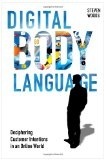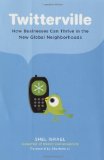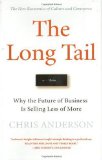Free Using Social Media eBook
I’m posting an updated version of a Social Media eBook I published a couple of years ago. The eBook is meant as a quick guide for getting started, addressing the following topics:
* Before you start
* Fish Where the Fish Are
* Developing Your Own Community
* Social Media Tools
* Measurement
What have you found to work best for you?
Social Media 101: Content Marketing
 Most social media campaigns begin with a bang – you’re excited, have a lot of passion and are regularly posting, tweeting and engaging your audience. If social media marketing isn’t your full-time role, other priorities begin to take priority once this initial excitement dissipates.
Most social media campaigns begin with a bang – you’re excited, have a lot of passion and are regularly posting, tweeting and engaging your audience. If social media marketing isn’t your full-time role, other priorities begin to take priority once this initial excitement dissipates.
Like your demand generation programs, the success of your social media marketing also depends on providing the right content to your audience at the right time during the sales cycle. Here are four quick ideas to keep your social media channels seeded with rich content:
Repurpose your content: Many companies have a huge reservoir of content ranging from product sheets to webinars, white papers and more. This content can be repurposed for your social media marketing efforts with minimal time and effort.
Editorial Calendar: Jumping into social media provides you the opportunity to publish content on your own timetable. To ensure that you stick to a schedule, map out an editorial calendar for the quarter looking at specific topics, guest authors, etc. to ensure that you have a rich funnel of content.
Interview Industry Experts: To vary the content and further position your company as an industry thought leader, interview industry experts and seed the interviews across your channels. You can do a quick video interview for YouTube, an email Q&A for your blog, or include profile in your email newsletter.
Invite Guest Bloggers: Creating all of this content is time consuming. Invite industry bloggers or peers to contribute a post to your blog. Make sure to set up some basic guidelines to ensure content is relevant to your audience. This alleviates your time constraints while provides content for your blog.
How do you keep your marketing and social media channels fresh with content?
Social Media Marketing 101 Posts
1. Social Media Strategy 101: Are You Ready?
2. Social Media Strategy 101: Definitions
3. Social Media Strategy 101: Which Persona Helps Tell Your Story?
#mptech Case Study of Viral B2B Video
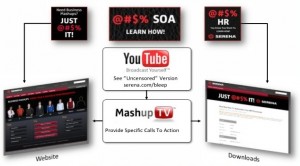 Rene Bonvanie, VP of Worldwide Marketing, Palo Alto Networks, presented on a viral video he created while with Serena Software. The goal of the video was to increase the use of the company’s mashup tools. Instead of creating a “standard” B2B video at the time, the company decided to adopt a more consumer-focused approach of using sex and innuendo. In essence, they were seeking to create a strong emotional response to the video – either you hated or loved it. I’ve embedded the original video below.
Rene Bonvanie, VP of Worldwide Marketing, Palo Alto Networks, presented on a viral video he created while with Serena Software. The goal of the video was to increase the use of the company’s mashup tools. Instead of creating a “standard” B2B video at the time, the company decided to adopt a more consumer-focused approach of using sex and innuendo. In essence, they were seeking to create a strong emotional response to the video – either you hated or loved it. I’ve embedded the original video below.
Starting a Fire
“No long tail in social media. It happens or doesn’t.” – Rene Bonvanie
While the video only cost $5,000 to develop, the challenge was generating the fire to start the buzz. The key considerations for Serena Software were:
* How to increase/enable social networking
* Have users push and syndicate the content rather than pushing it themselves
* Coordinated efforts with traditional media and advertising activities
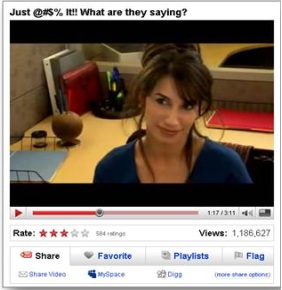 The company first created two versions of the video: a censored version for YouTube which linked to an uncensored version on the company’s website. The company then leveraged traditional advertisements on targeted websites that played on the “censored” theme. As the ad campaign continued, media outlets began to pick up on the, at the time, unique campaign.
The company first created two versions of the video: a censored version for YouTube which linked to an uncensored version on the company’s website. The company then leveraged traditional advertisements on targeted websites that played on the “censored” theme. As the ad campaign continued, media outlets began to pick up on the, at the time, unique campaign.
Simultaneously, the company built a video channel related to the original video. As the views increased for the viral video, other videos also saw an increase in views as a halo effect.
Questions from the audience
Note: I tried to capture the questions and quote as fully as I could and is not meant to be a “transcript” of what was said. Questions are in purple with the response italicized.
Insights with global marketplace and how to adapt this? One of the things we found is that from a B2B perspective, the audience speak English for B2B.
What was the magic sauce for the video? Sex and innuendo.
Had you thought of anything else besides sex/innuendo? Did take out some of the sex and tried the office/Seinfeld humor. Thought it was done before and wouldn’t go that well. Looked at consumer brands to see what they did and to combine those elements with office setting did well.
What was the impact on sales for the video? There were two ways to look at that. At the end of the day was to have people evaluate the software. Got $10 million in sales with $40 million in opportunities and 100,000 to conduct trials.
In conclusion, Bonanvie recommended caution when seeking to create such a video. You have to consider the creative, brand, comments from viewers, and related videos.
Other posts regarding MarketingProfs SocialTech 2010:
#mptech Motorola Case Study to Use Social Media for B2B Event
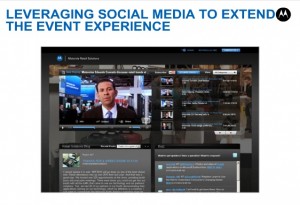 The session I was most interested in attending was the “B2B Events: Build Audience and Extend the Conversation through Social Media” at MarketingProfs SocialTech conferene. Belinda Hudmon, Sr. Director, Interactive Marketing, Motorola, shared how they leveraged social media for their events and to accelerate the sales cycle.
The session I was most interested in attending was the “B2B Events: Build Audience and Extend the Conversation through Social Media” at MarketingProfs SocialTech conferene. Belinda Hudmon, Sr. Director, Interactive Marketing, Motorola, shared how they leveraged social media for their events and to accelerate the sales cycle.
Start with the Customer
Motorola first started from the customer’s perspective to understand the pain point and sales cycle. The company levereaged in-depth research, customer insights and detailed personas to help develop digital toolkits to help prospects and customers through the sales process, such as microsites, product tours, website, social media and communities.
Events Key Part of B2B Sales
Events are key part of Motorola’s B2B sales but the recession impacted audience attendance (up to 50%+ decline for some key events) , especially since many of Motorola’s events were global. Interestingly, virtual events weren’t necessarily the answer as Motorola was cognizant of people’s limited time to participate in such an event.
According to Hudmon, they learned that 69% of business buyers use social media to make a purchase decision (Forrester). This, combined with the impact of the recession on event attendance, lead Motorola to develop its “Share the Experience” site. The goal of the site was to expand the experience for the event with video as the core. They leveraged several social media tactics to seed content and drive engagement:
* Uploaded videos to YouTube
* Had bloggers contributing insights about industry trends and from the industry floor to see what was happening
* Followed Twitter and Facebook to see what was happening via hashtags
* Provided access to initial information on case studies and other content from content sites, social media integration (e.g. flickr), etc.
* Promoted the site via email, twitter, and facebook to give info about the speakers, as well as feed information about the show back to their different social communities
* Recently provided mobile experience as well
Results: Increase Engagement, Thought Leadership and Post-Show Dialog
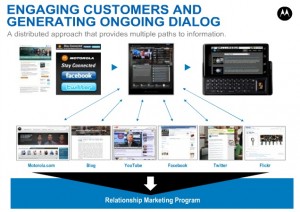
Overall, the “Share the Experience” site helped Motorola to establish a following with their customers, partners and prospects which extended their dialog with these key audiences. This also helped drive Motorola’s thought leadership platforms with blog postings and real-time updates from Twitter and Facebook. This has become an integral part of other shows and as a way to launch other thought leadership platforms.
Highlighting the value of archival content, Motorola discovered that 60% of the videos were watched after the event had concluded with 3X more demos completed online overall.
Questions from the Audience
Note: I tried to capture the questions and quote as fully as I could and is not meant to be a “transcript” of what was said. Questions are in purple with the response italicized.
Built the virtual conference platform internally for Motorola. Why internal vs external? Looked at virtual events and one of the issues with virtual events is that people’s time is limited. With the “Share the Experience” site, we weren’t trying to replace virtual but have an experience before, during or after the show. Have done some virtual that weren’t live stream and more on-demand scenario. Have tested the virtual event as an augmentation to events to see live and ask questions.
Social media integration – used corporate Motorola or different accounts within the event? Started by an event site but realized the opportunity was a Motorola site or audience-specific site. As set up the site and interface with it and can have a long-term interaction. So leverage the audience site to interface with event sites as they come online.
Conclusion
Motorola recognized that events were an integral part of their sales process, but the recession greatly impacted attendance at their global events. By understanding their customers – especially that these are time-constrained professionals, the company opted for a website-based experience integrated with social media versus a virtual event. In this way, Motorola discovered an effective way to drive engagement, thought leadership, and I’m assuming, sales forward.
How are you using social media to drive your B2B events? What other strategies are you using?
PRMM Interview – Maria Korolov of Hypergrid Business

In this week’s interview, I touched base with Maria Korolov of Hypergrid Business, a leading online blog on virtual worlds and environments. In three short years, she’s grown her business and I asked her thoughts regarding the virtual environments industry, what she attributes her success to, and what it will take to be covered by Hypergrid.
Biography: Maria Korolov (formerly Maria Trombly) is founder and president of Trombly International, a Massachusetts-based company which runs emerging markets news bureaus for US business and trade publications. Her clients include CIO magazine, Computerworld, Securities Industry News, CardLine Global, Waters, Reed Elsevier’s PharmAsia News, and dozens of other publications.
Can you tell us a little bit about yourself and Hypergrid Business?
I launched Hypergrid Business about a year and a half ago, shortly after I discovered OpenSim, as an excuse to learn more about the platform and to talk to the folks building it. Since then, we’ve grown to over 10,000 monthly readers, over a dozen columnists and paid writers, and we’re having to turn away advertisers due to lack of space.
OpenSim, and enterprises uses of virtual worlds in general, are a hot topic right now. The fact that I’ve got over a decade of experience covering enterprise technology for publications like Computerworld is paying off here.
And I’m having a blast. It’s great to be in at the very beginning of a significant structural change in how the world works. The shift to the Internet was one such change. I believe that the shift to immersive environments will be another, and will be equally disruptive and transformative to the global economy.
We’ve got ambitions plans for our company. We’ve already launched a newsletter, are finalizing a vendor directory, have a 300-destination hypergrid travel directory up, are developing a video program, and are building a hyperport with multiple locations to cover all the possible hypergrid travel destinations. Further down the line, we might rent out space to merchants in our hyperports, or create an in-world advertising network. We are looking for both technology and business partners, as well as writers, researchers, marketers, and other positions — all part-time to start with, but with potential to turn into real careers as this platform evolves.
You mentioned that your readership has grown over the past three years. What would you attribute your growth to?
Part of it is simply organic growth. Someone reads an article, recommends it to a friend, and the friend becomes a reader.
Part of it is social media. We’re on Twitter, Facebook, Digg… we try to make sure that every article we post is linked to from the major sites, as well as from BusinessWeek and LinkedIn.
We also make it easy for people to find us. We’ve been a Google News publication for around a year, and we’re near the top of the Google searches for relevant terms. Inbound links help drive up our rankings — and the more useful stories we publish, the more people link to us, and the easier it becomes to find us.
Marketers are more like publishers today. What tips would you provide to marketers to help drive their content marketing strategy?
Marketing is a big part of growing a new technology segment. Outreach and education are often neglected by technology folks, who assume that if they build a better platform, then people will come. That’s not always true — people won’t come unless they know it’s there, and unless they know what benefits it offers them. If a vendor is lucky, there will be a group of users who are active and vocal and go out and promote the technology, like Ener Hax is doing with SimHost’s OpenSim hosting service. Smarter vendors will seek out these folks and offer them discounted hosting or other incentives to get them to use and talk about their platform, instead.
It’s also great to get your name out in as many channels as possible. Virtual events and conferences, and face-to-face events. News articles. Published editorials. Press releases. Company blogs. Twitter, Facebook, and LinkedIn feeds. The more a customer hears about a company, the more comfortable he or she gets with it. This is where marketing experts come in. An outside social media consultant, teamed up with a freelance writer, can do wonders to raise a company’s profile in the marketplace.
They need to get to know the social landscape, find out where their customers hang out, follow them, and provide value to these communities.
As a blogger, what three tips would you provide to companies seeking to be profiled by Hypergrid?
First and foremost, I want customer case studies, success stories, testimonials, first-hand accounts of how your product or service works. Of course, I wouldn’t turn down a juicy disaster story, either! A smart company will take a disaster and spin it into a positive story of recovery and evolution. You’re guaranteed to get my attention with something like that.
Next, I want statistics. How many users? How many events? What percent were satisfied? What were the growth rates? What are the benchmarks? I love numbers, and readers love numbers.
Finally, and least interesting to me, are new product and version announcements. A company can put out a press release every week trumpeting a minor new feature. At a certain point, that gets boring — and not very useful to customers.
Anything else that you would like to share?
I’m always looking for guest columnists to talk about topics of interest to enterprise users of virtual worlds.
#mptech Guy Kawasaki Keynote and 6 Twitter Tips

I attended MarketingProfs SocialTech conferenceyesterday, which brought together a great roster of speakers including Jeremiah Owyang, Robert Scoble, Michael Brito, Laura Ramos and more. The ending keynote was Guy Kawasaki on how to use Twitter for B2B marketing.
I plan to post summaries of the sessions I waas able to attend either today or tomorrow, but wanted to start with Guy’s presentation first. Why? Because he decided to give an unusual keynote.
Instead of a straight forward keynote about the strategy of Twitter, he gave a more stream-of-consciousness look into how he uses twitter on a day-to-day basis. After a long day of sessions and enormous amounts of ideas/information, I thought this was an entertaining way to discuss why Twitter is integral for marketing and how to leverage it.
Be Memorable, Be an Expert – Six Tips for Twitter
1. “Sucking up is key”– Guy’s point is that you have to be kind to people on Twitter. This is one of the best ways to get people to follow and retweet you.
The Takeaway: Tweets are just a collection of letters and words. Intent can sometimes be misunderstood. As such, follow the Golden Rule and you will avoid any misunderstandings.
2. Be an expert –Want more followers? Be interesting. To do this, monitor those who are considered experts. When appropriate, share interesting feedback or content to be seen as intelligent contributor. Once they retweet your contributions, you’ll then be seen as an expert in turn.
The Takeaway: Be very clear on your messages and how you want to position your company on Twitter. Everything you tweet should be related to this to further position you and your company as an expert.
3. Use search intelligently– There are many ways to use search. The question is which parameters are you using? Consider searching beyond just the content of the tweet to look at profile information (search by title, geography, bio) or even look at tweets to and from a person. This helps you to better do points 1 and 2.
The Takeway: Conduct regular search to identify new influencers within your space.
4. “Tweet is the new haiku” – You only have 140 character. In order to capture attention, you have to be interesting. If you’re not the best person, then find someone who can.
The Takeaways: The best person to contribute to your Twitter feed may not even be in the marketing or PR department.
5. Social content curation – One of the controversial issues with Guy’s Twitter feed is his use of ghost contributors to his feed. In his keynote, Guys highlights how he collaborates with this group like a managing editor would with his writers. If he sees something interesting, but is unable to tweet or blog about it, he assigns the story to one of the appropriate ghost writers. This helps keep his content fresh while providing a benefit to his readers.
The Takeaway: Twitter never sleeps but individuals do. Instead of one person monitoring your Twitter stream, have a group of individuals within a corporation monitor and response for you customer support or brand management needs.
6. Be like CNN – Don’t assume everyone sees your tweet the first time. Consider tweeting 2-3 time during different time zones so the maximum number of followers see your tweet. (Note: according to Guy, this is against Twitter’s terms of use. Though he hasn’t been terminated for such behavior, he is probably an exception. Hint to Twitter – another way to generate revenue?).
The Takeaway: Marketers are content creators and publishers. In the case of Twitter, what may seem “spammy” may actually be the best strategy to ensure your message is seen and read by your customers, partners, and prospects.
Conclusion
The keynote didn’t have a direct way of presenting how one could use twitter for B2B marketing. Rather, Guy shared a collection of ideas and thoughts of his personal use to inform marketers on what could work for them. And depending on your needs, each marketer could walk away with a deeper understanding of how to use Twitter for her own marketing needs – both from a tactical and strategic perspective.
If you watched the keynote (either in person or virtually), what did you think? Do you agree or disagree with me? What takeaways did you have?
Book Review – Digital Body Language by Steven Woods
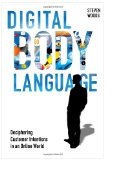 Over the past 10 years, we have seen the Internet and now Web 2.0 and social media technologies drastically change how marketers and public relations professionals engage with prospects, customers, employees and influencers online. As much of this interaction is being done online, the challenge is how marketers can “read” the digital signals to determine interest and intent. In a nutshell, how to provide the right information, to the right person, at the right time.
Over the past 10 years, we have seen the Internet and now Web 2.0 and social media technologies drastically change how marketers and public relations professionals engage with prospects, customers, employees and influencers online. As much of this interaction is being done online, the challenge is how marketers can “read” the digital signals to determine interest and intent. In a nutshell, how to provide the right information, to the right person, at the right time.
That is the premise of Steven Woods’ book, Digital Body Language. As co-founder of Eloqua, a marketing automation company, Steven provides insight into how marketers can translate these digital signals to increase the effectiveness of their marketing programs.
While the book is written with the marketer in mind, PR practitioners can benefit by reading this book as well. The step-by-step look into the customer’s digital psyche will help PR professionals understand the challenges that their marketing counterparts face. PR can help marketers understand behavior triggers; thereby recommending strategies, content and programs that drive these objectives forward. PR moves from being a “brand awareness” vehicle to a strategy that can pinpoint why and what will impact a customer’s behavior and interest.
For example, most executives want to business coverage regardless of how this coverage will or will not impact the bottomline. Yet, you strongly recommend a vertical program based on budget, time and objectives. If you can highlight how a vertical outlet program drove X% interest target prospects which uncovered $X in sales opportunities for a similar client, then not only will C-Level executives pay attention, but PR will also earn a seat at the table.
Isn’t this a strong value proposition?!
Conclusion
Steven provides marketers an understanding of the new digital body language. His approach is straight-forward with case studies to provide real-world implentation stories combined with helpful tips. I recommend this book for all PR practitioners and those entering the marketing field.
Let me know what you think of the book below in the comments or if you have any other must-read books.
I met Steven Woods at the Eloqua Experience 2010 Conference in October 2010.
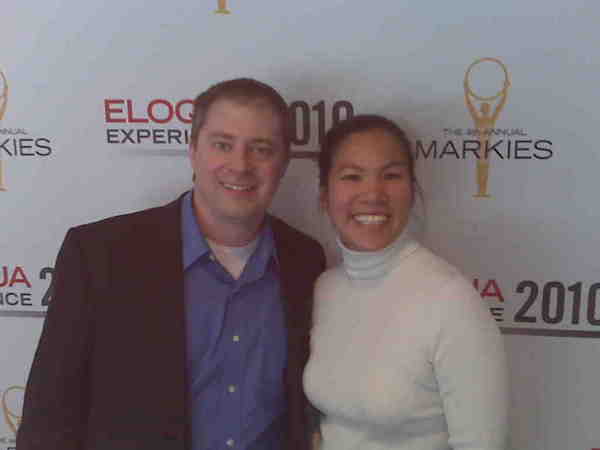
About
Favorite Service
Recent Comments
- on Going Virtual Isn’t Necessarily the Answer to Replacing Your Physical Events
- on Going Virtual Isn’t Necessarily the Answer to Replacing Your Physical Events
- on Going Virtual Isn’t Necessarily the Answer to Replacing Your Physical Events
- on Going Virtual Isn’t Necessarily the Answer to Replacing Your Physical Events
- on Going Virtual Isn’t Necessarily the Answer to Replacing Your Physical Events
Ads by Google
Favorite Books
Marketing Blogs
PR Blogs
- KD Paine's Measurement Blog
- Micro Persuasion
Virtual Events & Meetings Blogs
- Cisco Virtual Environments
- It's All Virtual
- The Webinar Blog
- Virtual Edge Institute

 Follow
Follow Cece Salomon-Lee is director of product marketing for Lanyon Solutions, Inc. and author of PR Meets Marketing, which explores the intersection of public relations, marketing, and social media.
Cece Salomon-Lee is director of product marketing for Lanyon Solutions, Inc. and author of PR Meets Marketing, which explores the intersection of public relations, marketing, and social media. 